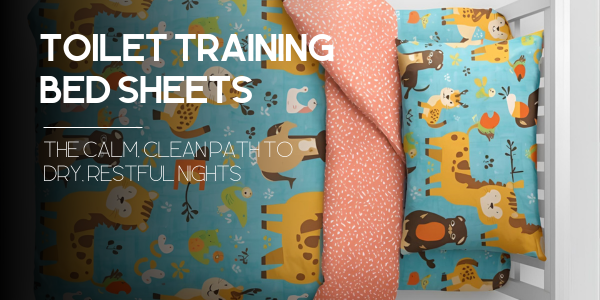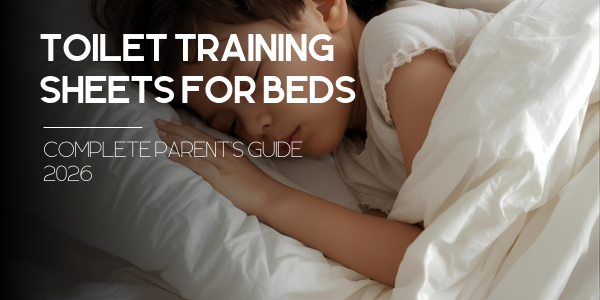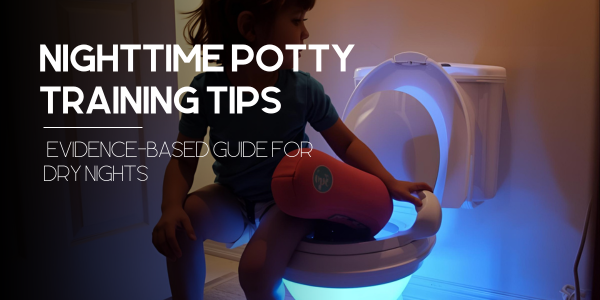Toilet Training Sheets for Beds: Complete Parent's Guide 2026
The Complete Guide to Toilet Training Sheets for Beds: Breaking the Silence on Nighttime Accidents
Normalizing the Conversation: You're Not Alone in This Journey
Here's what nobody's telling you at the playground: If your child is dealing with nighttime accidents, they're actually part of the majority, not the exception. Yep, you read that right.
Listen, we need to talk. And I mean really talk—about that thing nobody discusses at PTA meetings or playdate coffee chats. It's 2 AM. You're changing sheets. Again. Your exhausted kiddo stands there, tears threatening to spill, and you're both wondering if this nightmare (literally) will ever end.
Breathe. You've landed exactly where you need to be.
Let's shatter some silence with cold, hard facts that'll make you feel less alone. Over 5 million children in the US wake up to wet beds. That's enough kids to fill 100 football stadiums! Yet somehow, we're all pretending it's not happening in our homes.
The shame spiral? It stops here. Today.

See, toilet training sheets aren't just waterproof barriers between your kid and their mattress. They're dignity preservers. Confidence builders. And honestly? They're the unsung heroes of countless peaceful mornings where nobody has to strip beds before school.
Why Chooniez Gets It (And Gets You)
We're not just another company slinging waterproof products. We've been in those 2 AM trenches with you. We've felt that parental guilt wondering if we're handling things right. And we've engineered solutions that actually work—not just for keeping mattresses dry, but for keeping families sane.
What you're about to discover isn't your typical "10 tips for bedwetting" listicle. This is your comprehensive roadmap from frustration to freedom. We're talking science-backed strategies, real parent testimonials (the good, bad, and soggy), and product recommendations that'll transform your nights from battlegrounds to, well, just regular nights.
Quick Promise: By the end of this guide, you'll have everything needed to tackle nighttime accidents with confidence, compassion, and maybe even a little humor. Because if we can't laugh about the absurdity of washing sheets at 3 AM, what can we laugh about?
The Science Behind Nighttime Accidents (Spoiler: It's Not Your Kid's Fault)

Alright, time for some myth-busting that'll probably tick off your mother-in-law. Ready? Your 7-year-old isn't wetting the bed because they're lazy, rebellious, or drinking too much apple juice. There's actual, legitimate science happening here.
Understanding Developmental Timelines: When "Normal" Isn't What You Think
First things first—toss that arbitrary timeline out the window. You know, the one that says kids should be dry by age 3, 4, or whatever magical number someone made up. Here's what pediatric urologists actually know:
Answer: It varies wildly! Some kids are dry at 3, others at 10. Both are normal.
The bladder-brain connection is like WiFi installation—sometimes it connects instantly, sometimes you're on hold with tech support for years. And just like WiFi, you can't rush the process by yelling at it.
The Biological Mismatch Nobody Talks About
Picture this: Your kid's bladder capacity is roughly the size of their age plus two (in ounces). So your 5-year-old? They're working with about 7 ounces of storage. Now factor in that kids sleep deeper than exhausted parents after a Disney trip. Their brain literally doesn't register the "gotta go" signal.
It's not defiance. It's biology being a jerk.
And before you start side-eyeing your son, this gender gap has nothing to do with boys being "lazier" about potty training. It's hormonal, developmental, and completely out of anyone's control. Research shows boys' nervous systems simply mature differently, particularly the parts controlling nighttime bladder function.
Medical Perspectives Often Missed (Because Nobody Asks the Right Questions)
Here's where things get interesting—and by interesting, I mean frustratingly complex but totally explainable. There are actually two types of bedwetting, and knowing which one you're dealing with changes everything.
Primary vs. Secondary: The Plot Twist
| Primary Nocturnal Enuresis | Secondary Nocturnal Enuresis |
|---|---|
| Never been dry for 6+ months | Was dry, then started wetting again |
| Usually genetic (check your family tree!) | Often triggered by stress or changes |
| Accounts for 80% of bedwetting cases | May signal other issues needing attention |
| Typically resolves with maturation | May resolve once trigger is addressed |
Fun fact that'll blow your mind: If both parents wet the bed as kids, there's a 77% chance your child will too. One parent? 44% chance. Genetics are wild, aren't they?
The Hormone Nobody Mentions at Pediatric Visits
ADH—antidiuretic hormone. Remember that acronym because it's probably the real culprit behind your laundry mountain. This hormone tells kidneys to slow down urine production at night. Some kids' bodies are basically running the day shift 24/7, producing urine like it's high noon at midnight.
Imagine trying to hold a garden hose output in a coffee cup. That's what we're asking these kids to do.
When to Call the Pediatrician (Red Flags Checklist)
Look, I get it. Talking about your kid's bathroom habits with a medical professional feels weird. But pediatricians? They've heard it all. They've got solutions. And most importantly, they can rule out the stuff that needs ruling out while reassuring you about what's totally normal.
The Complete Guide to Toilet Training Sheets (Your New Secret Weapon)
Okay, let's get down to brass tacks. Or should I say, absorbent layers? Toilet training sheets have come a looong way from those crinkly, sweaty rubber sheets our grandparents used. We're talking space-age materials, whisper-quiet fabrics, and absorption levels that'd make paper towels jealous.
Types of Protection Solutions: Choose Your Fighter
Not all heroes wear capes—some come in fitted sheet form. Let's break down your options because, trust me, picking the right protection is like choosing the right coffee order. Get it wrong, and everyone's grumpy.
Disposable vs. Reusable: The Ultimate Showdown
Mind-blowing math alert: The average family dealing with bedwetting spends $1,200 annually on disposable products. That's a pretty sweet vacation fund going straight into the trash.
Look, I'm not here to shame anyone's choices. Sometimes, disposables are lifesavers (hello, vacation or grandma's house). But let's talk real numbers and real impact:
| Factor | Disposable Pads | Reusable Training Sheets |
|---|---|---|
| Annual Cost | $1,200-1,500 | $150-300 (one-time) |
| Environmental Impact | 7,000 pads = 1 ton of landfill | Machine washable for 300+ cycles |
| Middle-of-night Changes | Toss and replace | Quick swap if you have 2-3 |
| Comfort Level | Can feel plasticky | Soft, breathable fabrics available |
| Travel Convenience | No washing needed | Need access to laundry |
The verdict? Most families find reusable sheets pay for themselves within 2-3 months. Plus, you're not contributing to Mount Diaper in the local landfill. Mother Earth sends her thanks.
Material Science That Actually Matters
Time to get nerdy for a hot minute. The materials in modern training sheets are basically textile engineering marvels. We're not talking about your grandmother's rubber sheets that made kids sweat like they're in a sauna.
The Goldilocks of waterproof barriers—not too rigid, not too flimsy. TPU is breathable (yes, really!), which means less sweaty nights and more comfortable sleep. It's also completely silent, so no more crinkly announcements every time your kid rolls over. Think of it as the Tesla of waterproof materials—high-tech, efficient, and surprisingly elegant.
The old guard of waterproofing. They work, sure, but at what cost? These materials tend to be less breathable, noisier, and honestly? They can make bedtime feel more medical than cozy. If you're going this route, look for phthalate-free options. Your kid's health is worth the extra few bucks.
Welcome to the future, folks. Bamboo and Tencel (made from eucalyptus) are naturally antimicrobial, moisture-wicking, and softer than a puppy's ear. They're also sustainable, which means you can feel good about your purchase on multiple levels. Our latest tech combines these fibers with TPU backing for the ultimate in comfort and protection.
Sizing and Placement Strategies (Because One Size Doesn't Fit All)
Here's something nobody tells you: How you position these sheets matters as much as which ones you buy. It's like parallel parking—technique is everything.
Full Coverage vs. Targeted Protection
Some kids are stationary sleepers (lucky you). Others perform full gymnastics routines while unconscious. Your protection strategy needs to match your kid's sleep style:
For the Starfish Sleepers: Go full coverage. We're talking fitted waterproof sheets that cover the entire mattress, plus maybe a waterproof throw blanket for extra insurance. Yes, it's the nuclear option, but desperate times...
For the Statue Sleepers: You might get away with targeted pads placed strategically in the, ahem, splash zone. These are easier to swap out at 2 AM and less laundry if things go sideways. Or should I say, wetways?

The Bed Lasagna Method (Parent Hack of the Century)
Game-Changer Alert: Layer your bed like this: waterproof sheet, regular sheet, waterproof sheet, regular sheet. When accident happens? Peel off top layers, boom—fresh bed underneath. It's basically meal prep but for midnight emergencies.
This method has saved more parental sanity than coffee and wine combined. You're welcome.
Beyond the Sheets: Your Holistic Nighttime Training Battle Plan
Alright, real talk time. Toilet training sheets? They're your defensive line. But you need an offensive strategy too. Think of this as your comprehensive playbook for conquering nighttime accidents once and for all.
The Multi-Tool Approach (Because One Size Never Fits All)
Remember when you thought a baby monitor was all you needed for nighttime parenting? Ha! Same energy here. Successful nighttime training is like making the perfect sandwich—it's all about the layers.
Combining Sheets with Bedwetting Alarms
Now, before you roll your eyes at the idea of adding MORE gadgets to your parenting arsenal, hear me out. Bedwetting alarms paired with quality protection sheets show a 70% success rate within 3 months. That's better odds than your kid eating vegetables willingly.
These alarms work by conditioning the brain to recognize bladder signals. It's like Pavlov's dogs, but for peeing. And way less weird than that sounds.
Fluid Management Without the Trauma
Okay, controversial opinion incoming: Restricting fluids before bed is like trying to diet by not buying groceries. Sure, it might work, but at what cost to everyone's sanity?
Instead, try the "front-loading" approach:
- 60% of daily fluids before 2 PM
- 30% between 2 PM and dinner
- 10% after dinner (because we're not monsters)
This way, nobody's going to bed parched and resentful. Win-win.
Age-Specific Strategies (Because a 3-Year-Old and 13-Year-Old Are Different Species)
Toddlers (2-4 years): The Chaos Years
Ah, toddlers. They're like tiny drunk people with opinions about everything except using the toilet appropriately. If you're transitioning from diapers to training sheets, you're basically negotiating with a terrorist who loves goldfish crackers.
The "Big Kid Bed" Celebration Approach: Make the switch to training sheets a celebration, not a punishment. "You're such a big kid now, you get special sheets!" Kids eat this stuff up.
Pro moves for the toddler crowd:
- Visual cues everywhere (seriously, sticker charts are currency at this age)
- Routine is king—same potty time, same song, same celebration dance
- Never, EVER shame. They have their whole lives for that; let's keep bedtime positive
School-Age (5-10 years): The Secret Keeper Years
This is where things get emotionally complex. Your kid is old enough to feel embarrassed but not old enough to fully control the situation. It's like being stuck in emotional purgatory with a side of wet sheets.
The big fear? Sleepovers. Nothing says "social suicide" to a 8-year-old like wetting the bed at Tyler's birthday sleepover. This is where discrete products become crucial. Specialized sleeping bags with built-in protection can be absolute game-changers for maintaining social lives.
Tweens/Teens (11+): The "This Can't Be Happening" Years
If your teen is dealing with bedwetting, first off—massive virtual hug. This is tough terrain. The good news? Options exist that are so discrete, their siblings won't even know.
Key strategies for teens:
- Complete privacy and autonomy over their solution
- Medical consultation (hormonal changes can trigger secondary enuresis)
- Discrete products that look and feel like regular bedding
- Open communication without forced conversations
The Emotional Landscape: Supporting Hearts While Protecting Sheets
Let's address the elephant in the room—or should I say, the wet spot on the bed? The emotional toll of bedwetting can be heavier than a waterlogged mattress. And I'm not just talking about your kid's feelings.
Breaking the Shame Spiral (For Everyone Involved)
You know what's wild? Research shows that punishing bedwetting extends the problem by an average of 6 months. SIX. MONTHS. That's 180 more nights of laundry. Let that sink in before you lose your cool at 3 AM.
Language that helps: "Accidents happen, let's get you comfortable again."
Language that hurts: "You're too old for this" or "Why can't you just wake up?"
The truth? Your kid probably feels worse about it than you do. They're not doing this for attention or to ruin your sleep (though it might feel that way when you're running on 3 hours of shut-eye).
Creating a "No Big Deal" Culture
Here's the secret sauce: Make nighttime accidents as drama-free as spilling milk at dinner. The less emotional energy you put into it, the less anxiety your kid carries.
Some families even have a code word—"Code Neptune" or "Nighttime oops"—that makes it feel less medical and more like a minor inconvenience. Because honestly? That's all it should be with the right preparation.
Sibling Dynamics: When Brothers and Sisters Know
If you've got multiple kids, you're probably worried about sibling teasing. Here's your script: "Everyone's body develops differently. Remember when you couldn't ride a bike and your sister could? Same idea. We support each other in this family."
Also? Bribery works. "Anyone who teases loses screen time" is perfectly acceptable parenting here.
Your Practical Buyer's Guide: Choosing Training Sheets Like a Pro
Alright, let's get down to the nitty-gritty. You're ready to invest in quality protection, but the options are overwhelming. It's like standing in the cereal aisle—too many choices, all claiming to be the best.
Essential Features Checklist (Your Non-Negotiables)
Must-Have Features
Nice-to-Have Features
- Antimicrobial treatment (because nobody needs extra funk)
- Color options (dignity matters, even in protective bedding)
- Quick-dry technology (for those back-to-back accident nights)
- Hypoallergenic materials (sensitive skin is real)
Budget Considerations (Real Talk About Real Money)
Look, I know you'd spend your last dollar to help your kid, but you shouldn't have to. Let's break down the actual economics of bedwetting protection:
Hidden cost alert: The average mattress replacement due to bedwetting damage? $400-800. One quality waterproof protector? $40-80. The math isn't hard here, folks.
| Investment Level | What You Get | Best For |
|---|---|---|
| Budget ($30-60) | Basic protection, decent absorption | Occasional accidents, backup protection |
| Mid-Range ($60-120) | Quality materials, good durability, comfort features | Regular use, 2-3 nights per week |
| Premium ($120+) | Top materials, maximum comfort, longest lifespan | Nightly use, sensitive skin, long-term solution |
Pro tip? Start mid-range. You can always upgrade if needed, but most families find the sweet spot around $80-100 for a quality reusable system.
Top Recommendations by Situation
Best for Heavy Wetters
When we're talking flood-level situations, you need maximum absorption without compromising comfort. Look for multi-layer systems with at least 12 oz capacity. Modern ultra-absorbent pads can handle even the heaviest accidents.
Shop Heavy-Duty ProtectionMost Discrete Option
For older kids and teens who value privacy above all else, thin-profile protectors that look like regular mattress pads are key. No crinkles, no obvious waterproofing, just stealth protection.
Travel-Friendly Choice
Portable protection for vacations, sleepovers, and camp. Foldable, lightweight options that fit in a backpack without raising questions.
Budget-Conscious Pick
Quality doesn't always mean expensive. Some excellent options provide solid protection without the premium price tag. Many parents are surprised by how affordable quality washable pads can be.
Maintenance Mastery: Keeping Your Sheets Fresh and Functional
Let's be honest—if you're dealing with bedwetting, you're going to become a laundry expert whether you like it or not. Might as well master it, right?
Washing and Drying Protocols (The Science of Clean)

Here's something wild: Most people wash their training sheets wrong, which cuts their lifespan in half. It's like using dish soap in the dishwasher—seems logical until everything goes sideways.
The Perfect Wash Recipe
Golden Rule: Hot water for sanitation (140°F), cold rinse for longevity. It's the yin and yang of laundry.
Your step-by-step guide to laundry excellence:
- Pre-rinse in cold water - Gets rid of the bulk of the mess
- Wash hot with enzyme detergent - Breaks down proteins and eliminates odor
- Add 1/2 cup white vinegar to rinse cycle - Natural deodorizer and fabric softener
- Skip the fabric softener - It reduces absorption (rookie mistake!)
- Tumble dry low or line dry - High heat damages waterproof backing
Want to know the secret weapon? Enzyme cleaners on a rotation schedule can extend sheet life by 40%.
Emergency Night Protocol (Your 2 AM Game Plan)
It's 2:47 AM. The dreaded "Mom, Dad..." whisper comes from down the hall. You need a system that works when your brain doesn't.
The 2-Minute Bed Change System
Keep a "midnight emergency kit" next to the bed:
- Spare sheets and waterproof pad (pre-fitted if possible)
- Baby wipes for quick cleanup
- Fresh PJs
- Small towel
- Plastic bag for wet items
- Night light or flashlight
Parent Hack Supreme: The bed lasagna method mentioned earlier? It's literally a game-changer for middle-of-the-night changes. Peel off wet layers, boom—dry bed underneath. Your exhausted future self will thank you.
Special Circumstances: When Standard Solutions Need Tweaking
Not every kid fits into a neat little box, and that's okay. Actually, it's better than okay—it's what makes them awesome. But it does mean we need to think outside the standard playbook sometimes.
Special Needs Support (Because Every Kid Deserves Dignity)
If you're parenting a child with special needs, you're already a superhero in my book. Bedwetting might just be one more thing on a very full plate, but that doesn't make it less important to address with compassion and practical solutions.
Autism and Sensory Considerations
Kids on the spectrum often have heightened sensory awareness. That "whisper-quiet" waterproof sheet? Might sound like a thunderstorm to them. The key is finding materials that work with, not against, their sensory needs.
What works:
- Ultra-soft top layers (bamboo is often a winner)
- Consistent textures (no surprise crinkles)
- Familiar scents (wash new sheets multiple times before use)
- Visual consistency (same color/pattern for comfort)
Some families find success with hypoallergenic options that minimize sensory triggers.
Physical Disabilities and Adaptive Solutions
When mobility is a challenge, quick changes become even more complex. This is where innovative products really shine. Think beyond traditional sheets to full bed protection systems that can be changed without fully remaking the bed.
Beyond Childhood: The Reality Nobody Discusses
Plot twist: This isn't just about kids. Adult bedwetting affects more people than you'd think, and the shame factor is multiplied by about a thousand.
Common triggers for adult bedwetting:
- Pregnancy and postpartum recovery
- Medical procedures and medications
- Stress and anxiety (yes, really)
- Temporary health conditions
- Age-related changes
The good news? The same quality products that work for kids work for adults. The difference is in the marketing and the conversation around it.
When Sheets Aren't Enough: Knowing When to Level Up
Sometimes, despite your best efforts with training sheets and alarms, things aren't improving. That's not failure—that's data telling you it's time for a different approach.
Medical Intervention Indicators (The When-to-Worry Guide)
Time to See a Specialist If:
Medication Options (The Pharmaceutical Runway)
Look, nobody wants to medicate their kid unnecessarily. But sometimes, medication can be the bridge between frustration and success. Common options include:
- Desmopressin (DDAVP): Synthetic hormone that reduces nighttime urine production
- Anticholinergics: Helps calm overactive bladders
- Tricyclic antidepressants: Old-school but sometimes effective for severe cases
These aren't forever solutions—think of them as training wheels while the body catches up.
Alternative Approaches (When You're Ready to Try Everything)
Before you roll your eyes, hear me out. Some of these "alternative" approaches have surprising science behind them.
Evidence-Based Alternatives Worth Considering
| Approach | Evidence Level | Typical Timeline |
|---|---|---|
| Acupuncture | Moderate (several positive studies) | 8-12 weeks |
| Hypnotherapy | Limited but promising | 6-10 sessions |
| Chiropractic | Anecdotal | Varies widely |
| Dietary modifications | Strong for certain triggers | 2-4 weeks to see changes |
The dietary piece is interesting—some kids are sensitive to dairy, citrus, or artificial colors, which can irritate the bladder. Worth a elimination diet if you're desperate. And let's face it, if you're reading this far, you might be.
Building Your Village: Community and Support Resources
They say it takes a village to raise a child. Well, it takes a pretty understanding village to deal with bedwetting too. The good news? That village exists, you just need to find your people.
Online Communities (Your 2 AM Support Group)
When you're up at 2 AM changing sheets, knowing thousands of other parents are doing the exact same thing is weirdly comforting. Online communities provide that "you're not alone" feeling when you need it most.
Where to find your tribe:
- Facebook groups (search "bedwetting support" - private groups are goldmines)
- Reddit communities (r/Parenting has regular threads)
- Specialized forums on parenting sites
- Real stories from real families can be incredibly validating
Talking to Others (Scripts for Awkward Conversations)
The School Nurse Conversation
"Hi, I wanted to make you aware that [Child] is working through some nighttime continence issues. We have it managed, but in case of any field trips or overnights, I wanted you to be in the loop. Here's what works for us..."
The Sleepover Host Chat
"[Child] is so excited about the sleepover! Just FYI, we're dealing with occasional nighttime accidents. They have discrete protection and know how to handle it. If anything comes up, here's my cell..."
The Grandparent Education
"I know things were different when we were kids, but the current medical advice is to avoid shaming and let development take its course. Here's some current information if you're interested. What we really need is your support and patience."
Your Burning Questions Answered (No Judgment Zone)
Let's tackle the questions you're Googling at 3 AM but are too embarrassed to ask your pediatrician. No shame here—we've all wondered these things.
Quality sheets can last 300+ washes, which translates to about 2-3 years of regular use. The key is proper care—skip the fabric softener, avoid high heat, and follow manufacturer instructions. Cheap options might only last 6 months, so the "buy nice or buy twice" rule definitely applies here.
Yes, but layer smart! Put the heated pad under the waterproof protector. This keeps the heat function safe from moisture while still providing warmth. Just ensure your waterproof layer is breathable to prevent overheating. Pro tip: Some kids sleep deeper with warmth, which might affect nighttime dryness—experiment to find what works.
Think of it like this: Fitted sheets are full-body armor, bed pads are targeted shields. Fitted sheets cover the entire mattress and stay put no matter how much your kid moves. Bed pads protect specific zones and are easier to change mid-night but might shift with restless sleepers. Many families use both—fitted sheet as base protection, pad for easy swapping.
Absolutely! Look for sheets with higher edges or wings that tuck deep under the mattress. Side sleepers might also benefit from placing an additional pad vertically along their usual sleep position. The key is coverage where they actually sleep, not just the center of the bed.
The magic number is 3-4. Here's why: One on the bed, one in the wash, one drying, and one backup for those rough nights. If you're dealing with nightly accidents, lean toward 4. For occasional accidents, 2-3 works fine. Remember the bed lasagna method? That requires doubles of everything.
Sometimes! Many FSA/HSA plans cover them with a doctor's note stating medical necessity. Some insurance plans cover them under durable medical equipment. Get a prescription from your pediatrician—worst case, they say no. Best case, you save significant money. Always worth asking!
Size is the only real difference. Adult beds need larger coverage, but the technology is identical. Many manufacturers make "incontinence products" that are literally the same as kids' training sheets, just marketed differently. No shame in the game—protection is protection.
Make it exciting, not scary! Start with daytime success first, then introduce sheets as "big kid" bedding. Some families do a gradual transition—pull-ups with a training sheet underneath, then phase out the pull-ups. There's no rush. Every kid's timeline is different.
Old-school plastic ones? Absolutely. Modern breathable options? Not really. Look for TPU backing with cotton or bamboo tops. These allow air flow while blocking moisture. If sweating is an issue, layer a thin cotton sheet on top of the waterproof one. Technology has come a long way from the rubber sheets of yesteryear!
When accidents stop happening consistently. There's no magic age. Some kids need them until 7, others until 12. Some adults need them temporarily due to medical issues. The "right" age to stop is when they're no longer needed. Period. Anyone who tells you differently can do your laundry.
Your Family's Success Path: From Tonight Forward
Whew. We've covered a lot of ground, haven't we? From the science of sleep to the art of midnight sheet changes, you're now armed with more knowledge about bedwetting than you ever thought you'd need.
But here's what I really want you to remember...
The Big Takeaways (Your Cliff Notes)
- ✓ Bedwetting is common and temporary - This too shall pass
- ✓ Training sheets are tools, not solutions alone - Part of a bigger strategy
- ✓ Every child's timeline is unique - Comparison is the thief of joy
- ✓ Support and patience accelerate progress - Love conquers wet sheets
You know what's beautiful about this whole messy situation? It's teaching your kid that they're loved unconditionally. That accidents don't define them. That problems have solutions. These are pretty solid life lessons wrapped up in waterproof packaging.
Your Next Steps (The Action Plan)
Tonight, when you tuck your kid in, you're going to do it differently. Not because you've bought new sheets (though maybe you have), but because you understand what's happening. You've got tools, strategies, and most importantly, perspective.
The Chooniez Commitment (We're in This Together)
Look, we could end this with a sales pitch about our products being the best thing since sliced bread. But you know what? You're smart enough to make that decision yourself.
What we will say is this: We're here for the long haul. Our products are designed by parents who've been where you are. Our support doesn't end at checkout. And our commitment to dignity, quality, and actually solving problems (not just selling products) is unwavering.
Whether your journey to dry nights takes weeks, months, or years, we're honored to be part of it. Because every child deserves to wake up confident. Every parent deserves to sleep peacefully. And every family deserves products that actually deliver on their promises.
Ready to transform your nights?
Explore Chooniez SolutionsP.S. - To the parent reading this at 3 AM after yet another sheet change: You're doing amazing. Your kid is lucky to have you. And tomorrow night will be better. Promise.







Leave a comment